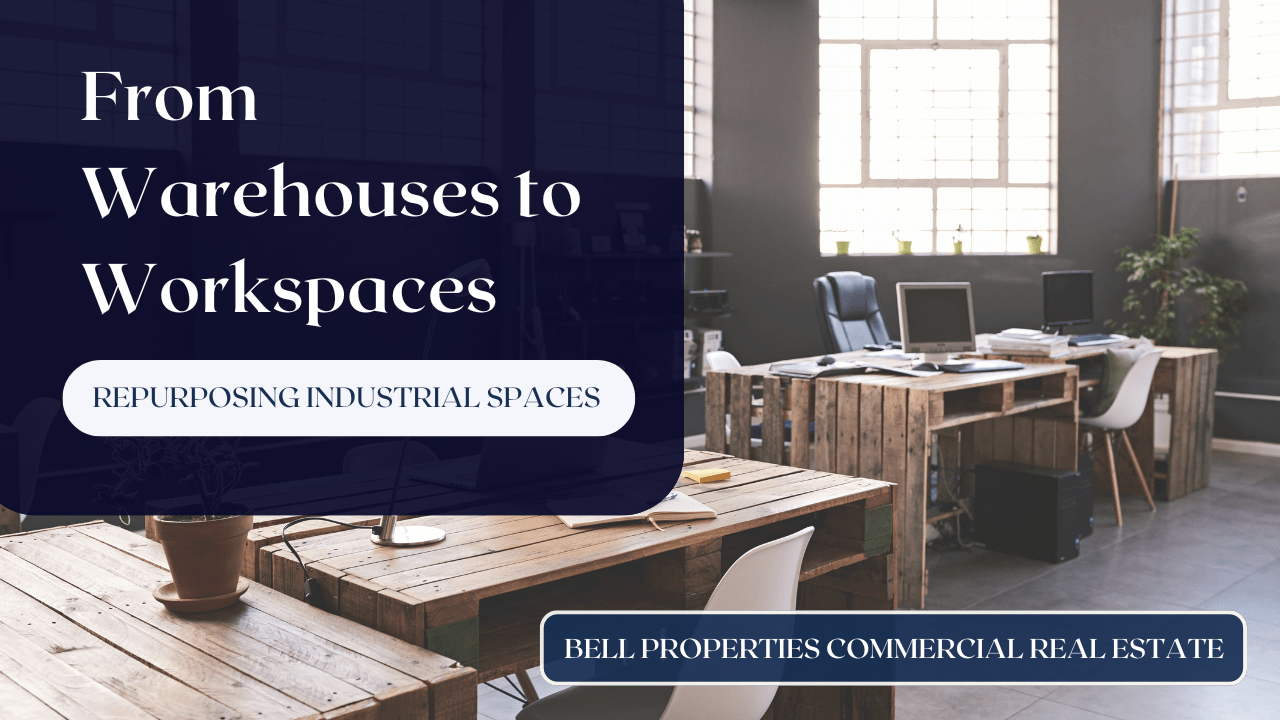Reusing, repurposing, recycling are all big buzzwords in a societal culture that wants to consume less and conserve more. That extends to commercial real estate, where a lot of commercial spaces were once something else.
Which brings us to a new trend: the art of transforming industrial spaces into thriving modern work environments. For a lot of investors, this is an exciting development that allows for modernizing and updating commercial spaces that already exist.
Industrial architecture offers a unique blend of historic character, durable construction, and expansive space, making it ideal for a wide range of contemporary uses, from offices to retail spaces and even residential lofts. This trend not only revitalizes neglected areas but also meets the increasing demand for unique, functional workspaces.
Commercial real estate investors interested in industrial spaces like warehouses and factories may want to consider turning those investments into modern workspaces. Contact us at Bell Properties Commercial Real Estate, and we’ll talk about how.
For now, let’s look at why this is such a good idea and where it might take a commercial real estate investor looking for creative ideas.
Advantages and Benefits to Repurposing Industrial Spaces
Here are some of the best reasons to turn commercial spaces that were once industrial into a commercial space that can be used for something else:
1. Unique Aesthetic Appeal
Industrial spaces often feature high ceilings, open floor plans, and large windows, which provide natural light and a sense of grandeur that is difficult to find in conventional office buildings. The aesthetic is likely to include exposed brickwork, steel beams, and original wooden floors. This can offer a desirable visual that appeals to creative businesses looking for inspiring environments. Commercial investors will have an easier time attracting good tenants when there are unique elements such as these.
2. Sustainability and Conservation
Repurposing existing structures aligns with sustainable development practices by reducing the need for new materials and minimizing environmental impact. The conservation of historical industrial architecture also preserves cultural heritage and contributes to the character of urban landscapes. This can be a major selling point for investors who want to attract commercial tenants looking for a greener rental experience.
3. Cost-Effective Development
Transforming industrial spaces can be more cost-effective than building from scratch. The basic structure is often already sound and suited to modern design requirements, saving on both time and resources during construction.
Which Industries are Looking for Repurposed Commercial Spaces?
 The shift away from traditional office environments has been driven by multiple factors, including a craving for authenticity, cost efficiencies, and sustainability goals. These rejuvenated spaces offer businesses a chance to stand out, attracting employees and customers with the charm and character that comes from their history as industrial spaces.
The shift away from traditional office environments has been driven by multiple factors, including a craving for authenticity, cost efficiencies, and sustainability goals. These rejuvenated spaces offer businesses a chance to stand out, attracting employees and customers with the charm and character that comes from their history as industrial spaces.
Here are some likely commercial tenants for such a space:
Technology
The tech industry is no stranger to innovation, but its latest trend is happening off-screen. Startups and established companies are gravitating towards repurposed industrial spaces, attracted by open floor plans and the industrial charm that fuels creativity. These spaces often come with the added advantage of increased square footage at a lower cost than traditional office buildings, making them an economical choice for growing tech businesses.
Creative Arts
Artists, designers, and other creative professionals are naturally drawn to spaces that inspire. Repurposed industrial workspaces offer high ceilings, ample light, and an abundance of character—features that creative industries find irresistible. From art galleries to design studios, these spaces often serve as blank canvases, customizable to suit the unique vision of each occupant.
E-commerce and Logistics
The surge in e-commerce has led to increased demand for strategically located distribution centers. Repurposed industrial facilities, often situated in urban areas, provide the ideal solution. These spaces offer the infrastructure needed for efficient operations, including loading docks and expansive floor plans, making them highly appealing to logistics companies looking to streamline their supply chains.
Manufacturing and Fabrication
While some industries pivot towards digital, manufacturing remains rooted in the physical. Repurposed industrial spaces provide the robust infrastructure and zoning necessary for light manufacturing and fabrication processes. With the shift towards localized production, these spaces allow manufacturers to remain close to their urban customer base, reducing transportation costs and lead times.
Hospitality and Events
The hospitality sector has witnessed a significant transformation with the advent of unique venues that cater to modern tastes. Repurposed spaces offer the perfect ambiance for trendy hotels, chic restaurants, and unforgettable event venues. These locations provide guests with an experience steeped in history and character, setting them apart from more conventional offerings.
From tech startups to logistics giants, a wide array of industries are recognizing the value of repurposed industrial workspaces. These unique environments not only offer practical benefits but also afford businesses the opportunity to differentiate themselves in a crowded market. Wondering how to reach them? Contact us at Bell Properties Commercial Real Estate, and we’ll help.
Commercial Property Management and Meeting Challenges

Repurposing industrial spaces into modern workspaces does come with some complexities and challenges.
Before you can start redeveloping an industrial site, it's important to understand the historical context and significance of the property. This requires research. Delve into the archives to uncover the history and previous uses of the space. This understanding can influence design choices and help in preserving key elements. Engage local communities to understand their attachment to the site. Collaborate to ensure that the redevelopment honors the space's history while meeting current needs.
One of the most significant challenges in industrial space redevelopment is dealing with environmental issues. Here's how to tackle them:
Conduct a Thorough Assessment. Before initiating any development, conduct a comprehensive environmental assessment to identify potential contaminants.
Plan for Remediation. Develop a remediation plan to address any environmental issues. This could include soil remediation, asbestos removal, or water treatment.
Work with Experts. Engage environmental specialists to guide your project through the remediation process and ensure compliance with regulations.
We can put investors in touch with environmental specialists and other professional partners. Contact us at Bell Properties Commercial Real Estate.
Redeveloping industrial spaces also involves navigating complex zoning laws and regulations. Review the existing zoning classifications and restrictions for the site under consideration. Investors will want to determine if rezoning is required to fit existing development plans. It’s also a good idea to establish a working relationship with local authorities to facilitate zoning changes, permit applications, and compliance with building codes.
Transforming industrial spaces into functional, modern developments presents unique design challenges as well:
Preserve Character. Investors will want to retain distinctive architectural features where possible, blending old and new designs to create a unique aesthetic.
Upgrade Infrastructure. It’s important to evaluate and upgrade existing infrastructure, including utilities, access roads, and public transport links, to support new developments.
Use the space innovatively. Employ creative design solutions to maximize space usage, such as open-plan layouts, shared amenities, and flexible workspaces.
Design Considerations for Repurposed Commercial Real Estate
When planning to invest in or develop repurposed workspaces, there are several design aspects to consider:
1. Functional Flexibility
The heart of any repurposed workspace is its ability to adapt to various needs. Designing flexible layouts with movable partitions and modular furniture can create multifunctional areas that tenants can customize as required. This flexibility is crucial for attracting long-term tenants who may have evolving space needs.
2. Technology Integration
Modern workspaces require robust technological infrastructure to support digital operations. Incorporating high-speed internet connectivity, smart lighting, and integrated AV systems will make the space more appealing to prospective tenants who prioritize tech-enabled environments.
3. Ergonomic and Aesthetic Appeal
The well-being of occupants should be a central focus in workspace design. This includes ergonomic furniture, ample natural light, and thoughtful acoustics to create a comfortable and productive environment. Additionally, incorporating elements like indoor plants and natural materials can enhance aesthetic appeal and contribute to occupant wellness.
4. Sustainability Practices
Implementing sustainable design practices not only reduces operational costs but also enhances the building's marketability. Consider incorporating energy-efficient HVAC systems, renewable energy sources, and sustainable building materials. These initiatives can also align with tenants' corporate social responsibility goals, making your property more attractive.
5. Community and Collaboration Zones
Creating spaces that foster community and collaboration can add significant value to repurposed workspaces. This includes open-plan areas, breakout zones, and communal kitchens that encourage networking and spontaneous interactions. Such features can be a major draw for businesses looking to foster a collaborative company culture.
Opportunities for Commercial Real Estate Investors

As the California commercial real estate market evolves, the demand for flexible, innovative workspaces is growing. Repurposing industrial spaces is an attractive solution for developers and investors for all the reasons we’ve already discussed.
Investors looking for opportunities should contact us at Bell Properties Commercial Real Estate. We can talk about key considerations for investors, including location and accessibility, zoning, infrastructure, and design upgrades.
The transformation of industrial spaces into innovative work environments presents a compelling opportunity for real estate investors. By understanding market drivers and key considerations, investors can successfully tap into this trend, creating dynamic, sustainable workspaces that meet the needs of today's workforce. Let’s talk about how to do it. Contact us at Bell Properties Commercial Real Estate.



